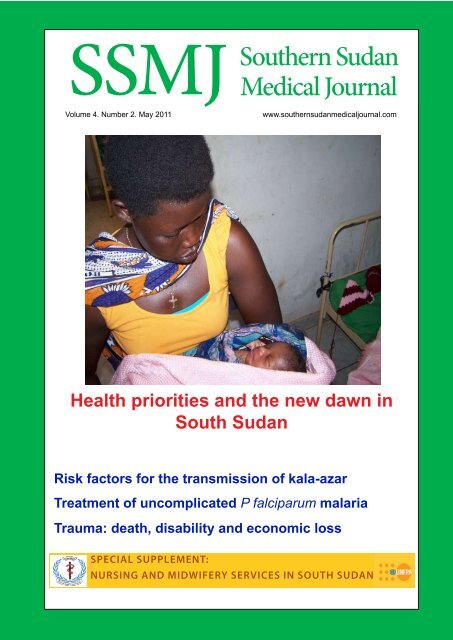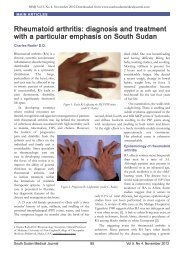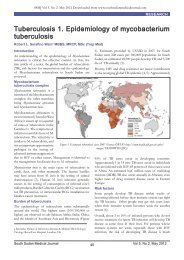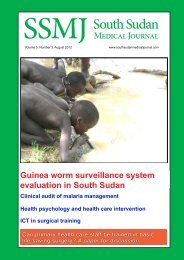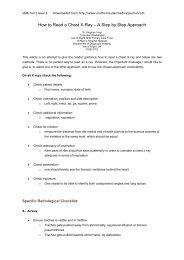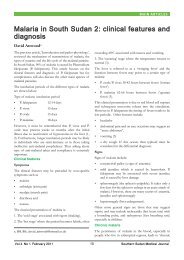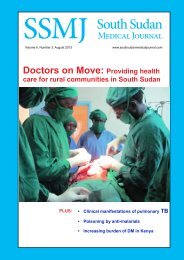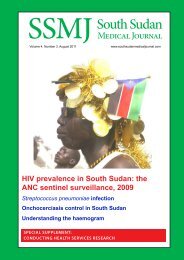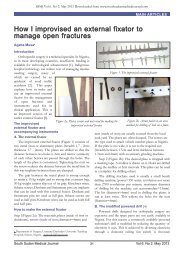Download Edition as PDF - South Sudan Medical Journal
Download Edition as PDF - South Sudan Medical Journal
Download Edition as PDF - South Sudan Medical Journal
You also want an ePaper? Increase the reach of your titles
YUMPU automatically turns print PDFs into web optimized ePapers that Google loves.
main articlesTable 3. Multiple logistic regression analysis for bed netuse and the occurrence of kala-azar infectionVariableDiscussionOR (95% C.I.) P- valueAlways uses bed net in rainy se<strong>as</strong>on 0.33 (0.15-0.72) 0.01Uses “Smoking” type of bed nets 2.55 (1.14-5.71) 0.02Figure 3. Patient with kala-azar seen during the 2010 outbreakat Fangar. He is visibly w<strong>as</strong>ted and h<strong>as</strong> an enlarged abdomen(splenomegaly).More than half of the participants affected by kalaazarwere children aged less than five years. The greatersusceptibility of the young children in the Fangak studycould be due to malnutrition and an immature immunesystem. Lack of knowledge on kala-azar treatment by thefamily may have contributed to patients coming late fortreatment.This study indicated the followingstatistically significant <strong>as</strong>sociations:• Engaging in night-time activities (e.g.dancing and games) incre<strong>as</strong>es the riskof kala-azar infection.• A person is two and half times morelikely to be at risk of getting kalaazarusing a “Smoking” bed net thana treated bed net. The re<strong>as</strong>on for thisis not clear. However the “Smoking”type of bed nets are made of light silk fibre so aree<strong>as</strong>ily blown away by the wind while the person issleeping.• The regular use of a bed net during the rainyse<strong>as</strong>ons provides a degree of protection fromkala-azar - a finding similar to that in a study fromBangladesh (10).Although it w<strong>as</strong> reported that almost everyone sleptunder a bed net, most used non-insecticide treated bednets. It w<strong>as</strong> reported that among the kala-azar c<strong>as</strong>esnobody w<strong>as</strong> sleeping under an insecticide-treated bed net;42% of c<strong>as</strong>es were using “Smoking” bed nets comparedwith 25% of the controls.Further analyses are needed to clarify the <strong>as</strong>sociationsbetween kala-azar and other types of non-treated bed nets,and whether people using “Smoking” bed nets are morelikely than others to be involved with night-time activities.It is hoped to publish these results later.The authors recommend incre<strong>as</strong>ed distribution oftreated bed nets and the expansion of kala-azar treatmentcentres in the county.ReferencesMurthi H. Upsurge of kala-azar c<strong>as</strong>es in <strong>South</strong>ern<strong>Sudan</strong> requires rapid response. WHO 2010 at http://www.who.int/leishmani<strong>as</strong>is/Upsurge_kalaazar_<strong>South</strong>ern_<strong>Sudan</strong>.pdf<strong>South</strong>ern <strong>Sudan</strong> <strong>Medical</strong> <strong>Journal</strong> 28Vol 4. No 2. May 20111.2. Médecins Sans Frontières. <strong>South</strong>ern <strong>Sudan</strong> ingrips of worst dise<strong>as</strong>e outbreak in eight years.http://www.doctorswithoutborders.org/press/rele<strong>as</strong>e.cfm?id=4924&cat=press-rele<strong>as</strong>e 20103. Desjeux P. (1992). Human leishmani<strong>as</strong>is: epidemiologyand Public health <strong>as</strong>pects. Wrld Hlth Stat Q. 45; 267-754. WHO. 2002. Available at www.who.int/tdrold/dise<strong>as</strong>es/leish/dise<strong>as</strong>einfo.htm5. Agrawal S, Rai M and Sundar S. Management of visceralTable 4. Bivariate analysis for environmental factorsVariables OR (95%C.I.) P-valueKeep sleeping on damp/wet floor 1.30 (0.64-2.64) 0.47Cracks inside or outside sleeping house 1.20 (0.61-2.51) 0.55Sleeping house less than 100m 1.34 (0.67-2.69) 0.41from the river/stagnant water sourceHouse near an anthill 1.89 (0.94-3.80) 0.07House near Acacia seyal (Seb or Luor) 0.84 (0.41-1.72) 0.63House near Balanites aegyptiaca (Thaou) 1.90 (0.93-3.88) 0.08House near Azadiracta indica (Neem) 0.72 (0.35-1.52) 0.39Occ<strong>as</strong>ionally play in the dark in the 2.36 (1.16-4.80) 0.02forest or around houses
main articlesTreatment of kala-azarThe official guideline adopted by the Ministry of Health is:1. Sodium stibogluconate (20mg/kg)/day and paromomycin (15 mg/kg)/day for 17 days2. Sodium stibogluconate 20mg/kg/day for 30 days3. Liposomal amphotericin 3-5mg/kg/day infusion for over 6-10 days up to a total of 30mg/kg4. Amphotericin B deoxycholate 0.75-1 mg/kg/day by infusion daily or on alternate days for 15-20doses5. Miltefosine orally at 2.5 mg/kg/day for 28 daysNB: The first three are the medicines currently in use in <strong>South</strong> <strong>Sudan</strong>.Table 5. Multiple logistic regression analysisEnvironmental variables OR (95% C.I.) P- valueB. aegyptiaca in the compound 1.90 0.93-3.88 0.08Ant hills near home 1.88 0.94-3.80 3.80Often spends time in night time activities(traditional dances and children games)2.59 (1.20-5.57) 0.01leishmani<strong>as</strong>is: Indian perspective. J Post grad Med. 200551; 53-576. Boelaert M, Criel B, Leeuwenburg J, Damme van W,Le Ray D and Van der Stuvft P. Visceral leishmani<strong>as</strong>iscontrol: A public health perspective. Trans R Soc TropMed Hyg. 2000. 94; 465–4717. Osman OF, Kager PA and Oskam L. Leishmani<strong>as</strong>is inthe <strong>Sudan</strong>: a literature review with emph<strong>as</strong>is on clinical<strong>as</strong>pects. Am J Trop Med Hyg. 2000. 18; 1091-12108. Quate LW. Phlebotomus sandflies of the Paloich Areain the <strong>Sudan</strong> (Diptera, Psychodidae). J Med Ento mol.1964 1; 213-2689. Minter DM, Wijers DJB, Heisch RB and Manson-BahrPEC. Phlebotomus martini, a probable vector of kalaazarin Kenya. Br Med J. 1962. 2; 83510.Caryn B, Allen WH et al, Risk Factors for Kala-azarin Bangladesh. Emerg Infect Dis 2005 May. AvailableFigure 4. Types of bed nets in use (Smoking on left andDhamoria on right).at http://www.cdc.gov/ncidod/EID/vol11no05/04-0718.htmFurther reading• Kolaczinski J, Hope A, Rumunu J, Richer M, Ruiz JA& Seaman J. Kala-azar Epidemiology and Control,<strong>South</strong>ern <strong>Sudan</strong>. Emerging Infectious Dise<strong>as</strong>es 2008.14: 664-666. http://www.malariaconsortium.org/pages/ntd_resources.htmAll photographs by John Lagu<strong>Sudan</strong> medical council starts work in jubaThe <strong>Sudan</strong> <strong>Medical</strong> Council, <strong>South</strong>ern <strong>Sudan</strong> branch h<strong>as</strong> opened in Juba and is temporarily housed at the Ministry of Health,Ministerial Complex Juba. Therefore all medical and allied health professionals delivering health services in <strong>South</strong>ern <strong>Sudan</strong>are required to be registered and to legalise their practices with immediate effect. The health professionals include Specialists,Consultants, Doctors, <strong>Medical</strong> Assistants, Clinical Officers, Dentists, Dental Technicians, Nurses, Midwifes, Pharmacists,Laboratory Technologists, Technicians, etc.For more information and conditions of eligibility for registration, see the notice board at the <strong>Medical</strong> Council office at theMinistry of Health, Juba or email: ssmedicalcouncil@gmail.com. More information may be found on the SSMJ website.SSMJ would like to thank the authors of articles and everyone else who helped to prepare this issueincluding Charles Bakheit, John Adwok, Stanley Mw<strong>as</strong>e and Ruth Parent.Vol 4. No 2. May 201129<strong>South</strong>ern <strong>Sudan</strong> <strong>Medical</strong> <strong>Journal</strong>
main articlesMalaria in <strong>South</strong> <strong>Sudan</strong> 4: treatment ofuncomplicated P. Falciparum malariaIn the February 2011 issue of SSMJ we covered the pathophysiology, and • overcome the threat of resistance of pl<strong>as</strong>modiumclinical and laboratory diagnosis of malaria (1, 2, 3). In this article we falciparum to monotherapies.deal with the treatment of uncomplicated malaria. Management of malariaArtemisinin derivatives should be one of the drugs inamong pregnant women and children, and treatment of severe malana willa combination.be published in future issues of this journal.Uncomplicated malaria is “symptomatic malariaArtemisinin b<strong>as</strong>ed combination therapies (ACTs)without signs of severity or evidence (clinical or laboratory) ACT is a combination therapy where one of theof vital organ dysfunction”. Cure is defined <strong>as</strong> “the components is artemisinin or its derivative (artesunate,elimination from the body of the par<strong>as</strong>ites that caused artemotil, artemether, dihydroartemisinin). Artemisininthe illness. This prevents progression to severe dise<strong>as</strong>e, derivatives are rapidly acting schizonticidal drugs capable ofand additional morbidity <strong>as</strong>sociated with treatment failure reducing par<strong>as</strong>ite biom<strong>as</strong>s by a factor of 104 each <strong>as</strong>exual(4)”.life cycle. Another advantage of artemisinin derivatives istheir ability to kill gametocytes, hence interrupting malariaThe primary aim of treatment is to cure the infectiontransmission.<strong>as</strong> rapidly <strong>as</strong> possible so it does not deteriorate into severemalaria. The public health (or secondary) aim is to reduce To eliminate at le<strong>as</strong>t 90% of the par<strong>as</strong>itaemia, a 3-daytransmission to others and prevent the emergence and course of the artemisinin is needed to cover up to threespread of resistance to anti-malarial medicines.post-treatment <strong>as</strong>exual cycles of the par<strong>as</strong>ite. This leavesAnti-malarial drugsa much smaller number of par<strong>as</strong>ites (10%) for the partnerdrug to kill while its concentration in pl<strong>as</strong>ma remainsAnti-malarial drugs can be cl<strong>as</strong>sified by their action on high.different stages of the malaria par<strong>as</strong>ite:ACTs recommended by WHO are:1. Tissue schizonticide (primaquine)• Artesunate + amodiaquine2. Blood schizonticide (chloroquine, sulphadoxinepyrimethamine,quinine, mefloquine and artemisinins)• Artemether + lumefantrine3. Gametocytocide (artemisinins and• Artesunate + mefloquineprimaquine).• Artesunate + sulfadoxine-pyrimethamineAnti-malarial combination treatments• Dihydrortemisinin + piperaquineAnti-malarial combination treatments are the For the treatment of uncomplicated malaria in <strong>South</strong>simultaneous use of two or more blood schizonticidal <strong>Sudan</strong>:drugs with independent modes of action and unrelated• The recommended first line medicine isbiochemical targets in the par<strong>as</strong>ites (i.e. the partner drugsArtesunate/Amodiaquine.in a combination must be independently effective). Theyare recommended by World Health Organization (WHO) • The recommended second line medicine isbecause they have the potential to:Artemether/Lumefantrine (Coartem®)• delay the development of resistance to the ACTs are available <strong>as</strong>:individual anti-malarials in the combination • Two medicines contained in one tablet i.e. they• improve treatment outcomesare fixed-dose artemisinin b<strong>as</strong>ed combinationtreatments.a MD, MSc. Tropical Dise<strong>as</strong>e Control, Senior Technical Advisor,Management Sciences for Health, NMCP MOH, <strong>South</strong>ern <strong>Sudan</strong>• Separate medicines packaged together (copackagedor co-blistered). However, the publicRAzairwe@msh.orgACT supply h<strong>as</strong> shifted from co-blistered tob MD. Lecturer, Dept Pediatrics and Child Health, Makerereco-formulated or Fixed Dose Combination ofUniversity College of Health Sciences, Kampala achanj@yahoo.co.ukASAQ.Robert Azairwe a and Jane Achan b<strong>South</strong>ern <strong>Sudan</strong> <strong>Medical</strong> <strong>Journal</strong> 30Vol 4. No 2. May 2011
main articlesTable 1. Artesunate Amodiaquine Fixed Dose Combination (Winthrop®)Age Infant 2 months –11 monthsTreatment regimesToddler 1 – 5 yrs Child 6yrs – 13 yrs Adolescent/Adult≥14 yrsWeight >4.5 – 9 – 18– 35 From 12 years and above 4 tablets12 hourly1 tablet12 hourly2 tablets12 hourly3 tablets12 hourly4 tablets12 hourly1 tablet12 hourly2 tablets12 hourly3 tablets12 hourly4 tablets12 hourlyYellowBlueBrownGreenVol 4. No 2. May 201131<strong>South</strong>ern <strong>Sudan</strong> <strong>Medical</strong> <strong>Journal</strong>
main articlesPregnant women and young infantsPregnant women should not take Artesunate/Amodiaquine or Artemether/Lumefantrine in the first trimester. Artemether/Lumefantrine is contraindicated for children below 5kg body weight. Such patients should be treated with oral Quinine (at a doseof 10mg/kg). In very young infants it is important to exclude other causes of fever.Management• improve the understanding of malaria• Treatment failure within 14 days of receiving an • improved adherence to full treatmentACT is unusual, but if it occurs treat with a 2ndlineantimalarial (i.e. Artemether /Lumefantrine).• minimize the use of inappropriate anti-malarials.• promote the use of malaria prevention tools• Treatment failure after 14 days of initial treatment especially insecticide-treated bed nets (ITNs).should be considered <strong>as</strong> a new infection andtreated with the first-line ACT (i.e. Artesunate/HIV infectionAmodiaquine).Worsening HIV-related immunosuppression maylead to more severe manifestations of malaria. In stableendemic are<strong>as</strong>, HIV-infected patients with partial immunityto malaria may suffer more frequent and higher densityinfections. It is recommended that:Other <strong>as</strong>pects of managementIncorrect approaches to treatmentDo not:• use artemisinins <strong>as</strong> monotherapy <strong>as</strong> this promotesresistance.Patients who cannot take oral medicineSome patients need parenteral or rectal administrationfor 1–2 days until they can swallow and retain oralmedication reliably. Although such patients may nevershow other signs of severity, they should receive the sameinitial anti-malarial dose regimens <strong>as</strong> for severe malariafollowed by a full 3-day course of ACT.AntipyreticsFever is a key sign of malaria and is <strong>as</strong>sociated withtiredness, weakness, headache, anorexia and often nausea.Treat with antipyretics and, if necessary, fanning andtepid sponging. Antipyretics should be used if coretemperatures ≥ 38.5ºC.Paracetamol (acetaminophen) 15 mg/kg every 4 hoursgiven orally or <strong>as</strong> a suppository is safe and usually welltolerated. Do not give acetylsalicylic acid (<strong>as</strong>pirin) tochildren because of the risks of Reye’s syndrome.AntiemeticsVomiting is common in acute malaria and may besevere. It is not known if antiemetics are effective butthere is no evidence that they are harmful, though theycan m<strong>as</strong>k severe malaria. Patients that vomit everything,including anti-malarials, should be managed <strong>as</strong> severemalaria.Health educationPublic education should be given at health facilitiesand schools, and by pharmacists and anyone prescribingand dispensing anti-malarials. This can:• patients with HIV infection who develop malari<strong>as</strong>hould receive prompt, effective anti-malarial treatmentregimens <strong>as</strong> recommended in the relevant sections of theWHO guidelines (1).• intermittent preventive treatment withsulfadoxine-pyrimethamine should not be given to HIVinfectedpatients receiving cotrimoxazole (trimethoprimplus sulfamethoxazole) prophylaxis.• treatment in HIV-infected patients on zidovudineor efavirenz should, if possible, avoid amodiaquinecontainingACT regimens.• the use of malaria prevention tools like insecticidetreatedbed nets should also be promoted in HIV-infectedindividuals.ReferencesCornelio C.O. & Seriano F. Malaria in <strong>South</strong> <strong>Sudan</strong>:1. Introduction and pathophysiology SSMJ. 2011.1(1):7-9Attwood D. Malaria in <strong>South</strong> <strong>Sudan</strong>: 2. Clinical featuresand diagnosis SSMJ. 2011. 1(1):10-12Cornelio C.O.Malaria in <strong>South</strong> <strong>Sudan</strong>: 3. Laboratorydiagnosis SSMJ. 2011. 1(1):13-16WHO Guidelines for the treatment of malaria. Secondedition 2010Ministry of Health GOSS. Guidelines for managementof malaria in <strong>South</strong>ern <strong>Sudan</strong> 2008Ministry of Health GOSS. <strong>South</strong>ern <strong>Sudan</strong> introducesFixed-dose Artesunate Amodiaquine. Malaria ControlDepartment.<strong>South</strong>ern <strong>Sudan</strong> <strong>Medical</strong> <strong>Journal</strong> 32Vol 4. No 2. May 20111.2.3.4.5.6.Note: This article is b<strong>as</strong>ed on the powerpoint presentation ‘Drug treatment ofmalaria’ by Jane Achan
main articlesPreventing malaria during pregnancy: factorsdetermining the use of insecticide-treated bednetsand intermittent preventive therapy in JubaRobert P. Napoleon a , Amwayi S. Anyangu b , Jared Omolocan c and Juliet R. Ongus dThe World Health Organization (WHO) recommendsIPT in pregnancy after studies showed that it reduced theprevalence of maternal anaemia and low birth weight (4,5). The drug acts by clearing malaria par<strong>as</strong>ites from theplacenta during the period of rapid foetal growth (6).To date there is no documentation on the coverageand determinants of the use of ITN or IPT in pregnancyin <strong>South</strong> <strong>Sudan</strong>. So the objective of this study w<strong>as</strong> to fillthis information gap.MethodsA cross-sectional study w<strong>as</strong> carried out betweenSeptember and November 2009 at Juba TeachingHospital (JTH). The Cochran formula (z2x p (1-p)/d2)w<strong>as</strong> used to estimate the minimum sample size <strong>as</strong>sumingthe proportion of pregnant women using ITN (or IPT)w<strong>as</strong> 33% (8, 1), a 95% confidence interval and a precisionof 5%.a MBBS, MSc. Directorate of Preventive Medicine, Ministry ofHealth, Government of <strong>South</strong>ern <strong>Sudan</strong>,patmokili@yahoo.com, patmokili@gmail.comb MBChB, MSc. Field Epidemiology and Laboratory TrainingProgramme (FELTP), Kenya amwayi2004@yahoo.comc MBBS, MSc. Field Epidemiology and Laboratory TrainingProgramme (FELTP), Kenya. jaredom2000@yahoo.com,d MSc, PhD. Institute of Tropical Medicine and Infectious Dise<strong>as</strong>es(ITROMID), Jomo Kenyatta University of Agriculture andTechnology, Kenya. julietteongus@yahoo.co.ukAbstractThe study w<strong>as</strong> carried out among 334 pregnant and newly delivered women seen at Juba Teaching Hospital in 2009. The objectivew<strong>as</strong> to <strong>as</strong>sess the coverage of insecticide-treated bed-nets (ITN) and Intermittent Preventive Therapy (IPT) among these womenand the factors <strong>as</strong>sociated with their use. Overall 87% of the women used ITN and 61% used IPT. ITN use w<strong>as</strong> positively <strong>as</strong>sociatedwith buying nets, indoor spraying of insecticide and higher household income. IPT use w<strong>as</strong> positively <strong>as</strong>sociated with morefrequent antenatal clinic visits, indoor spraying and buying ITN.IntroductionThe participants were pregnant women attending theStudies show that malaria infections are higher in first andante-natal clinic (ANC) in their second and third trimesterssecond pregnancies than subsequent ones (1). In <strong>South</strong>and women in the maternity ward in the immediate period<strong>Sudan</strong>, <strong>as</strong> in other places, malaria is a cause of:after delivery. Every sixth woman meeting the inclusioncriteria and giving her consent w<strong>as</strong> selected. A total of 334• maternal anaemiawomen were recruited – 167 from ANC and 167 from the• intra-uterine growth retardationward. Data were collected on:• low birth weight• use of ITN and IPT during pregnancy• stillbirths and abortions, and• attitudes towards IPT• maternal mortality (2, 3)• how bed-nets were acquired• ANC attendance• indoor spraying of insecticide• general knowledge and attitudes about the causeand prevention of malaria• age, employment, education, monthly householdincome and parity.Statistical AnalysisEpi Info version 3.4.3 statistical software w<strong>as</strong> usedfor data entry and analysis. A descriptive statisticalanalysis w<strong>as</strong> carried out on the use of ITN. Differences inproportions were analyzed using Chi square tests or Fisherexact test where appropriate. During bivariate analysis forfactors <strong>as</strong>sociated with ITN and IPT use the me<strong>as</strong>ure of<strong>as</strong>sociation w<strong>as</strong> Odds Ratio (OR). A P-value ≤ 0.05 w<strong>as</strong>considered a statistically significant <strong>as</strong>sociation.Factors that were significant during bivariate analysis(P≤0.05) were used <strong>as</strong> independent variables in theunconditional multiple logistic regression where abackward stepwise elimination method w<strong>as</strong> used to obtainthe final model. During the backward stepwise methodsall the significant factors were entered in the model andthe regression run until only factors that were significant(at P≤0.05) were retained in the model which w<strong>as</strong> thefinal “best” model. This allowed for the <strong>as</strong>sessment ofVol 4. No 2. May 201133<strong>South</strong>ern <strong>Sudan</strong> <strong>Medical</strong> <strong>Journal</strong>
main articlesMinistry of Health guidelines for reducing malaria during pregnancy.In accordance with WHO recommendations, the guidelines for reducing malaria during pregnancy in <strong>South</strong> <strong>Sudan</strong> are:•••treat clinical malariapromote the use of insecticide-treated bed-nets andprescribe Intermittent Preventive Therapy. Give at le<strong>as</strong>t two doses of sulfadoxine-pyrimethamine (SP) tablets at one monthintervals, beginning after quickening in the second trimester. Give at le<strong>as</strong>t three doses to HIV infected women (7).SSMJ plans to have an article on malaria in pregnancy in a future issue.me<strong>as</strong>ures of <strong>as</strong>sociation among nested levels of thefactors retained in the model.ResultsSocio-demographic characteristics of participants(for full details see Table 1 in the Annex in the version of thisarticle published on the SSMJ website)The majority of women were in the 18-31 year agegroup (the mean age w<strong>as</strong> 24 (±5.4) years); most wereunemployed or housewives (74%) and Christian (79%).Two thirds had attained primary or secondary educationwhile 27% had not gone to school. The monthly incomeof the husbands of more than half of the women w<strong>as</strong>between 500-1000 <strong>Sudan</strong>ese pounds (approximatelyUS$185-370).The overall use of ITN w<strong>as</strong> 87% (n = 296; 95% CI= 85% - 92%) and of IPT w<strong>as</strong> 61% (n = 204; 95% CI =56% - 63%). The use of ITN and IPT w<strong>as</strong> highest amongwomen who:• were aged 32 years and above• were formally employed• had attained secondary school education• had a monthly household income above 1,000<strong>Sudan</strong>ese Pounds.There w<strong>as</strong> no significant difference in use of ITN andIPT among Christians and Muslims.Factors <strong>as</strong>sociated with ITN use (for full details see Table2 in the Annex in the version of this article published on the SSMJwebsite)Bivariate analyses for factors <strong>as</strong>sociated with ITNuse showed that the following factors were statisticallysignificant at P≤ 0.05: buying ITN; being on the third ormore ANC visit; household monthly income of ≤ US$100; use of indoor spraying to prevent mosquito bites;no education; doing nothing to prevent mosquito bites;Christianity; awareness that mosquitoes cause malaria anduse of IPT.These factors were used to obtain the final “bestfit model” and only three of these were independently<strong>as</strong>sociated with ITN use in pregnancy in the study. Thosewho had bought ITNs and those who used residual indoorspraying were more likely to sleep under insecticide treatednets. However women with low incomes were found tobe less likely to use bed-nets.Factors <strong>as</strong>sociated with IPT use (for full details see Table3 in the Annex in the version of this article published on the SSMJwebsite)Bivariate analyses for factors <strong>as</strong>sociated with IPTuse showed that the following factors were statisticallysignificant at P≤ 0.05: buying ITN; being on the third ormore ANC visit; a household monthly income of ≤ US$100; use of indoor spraying for preventing mosquitobites, no education and starting ANC at above six monthsgestation.Again, from the final best fit model only three factorswere found to be independently <strong>as</strong>sociated with IPT use,namely, the buying of ITN, use of indoor spraying, andhaving attended three or more ANC visits.DiscussionEighty seven percent of women reported using ITN.This is almost twice that reported in Tanzania (9) andsurp<strong>as</strong>sed the target for the Abuja Declaration which set atarget of 60% ITN coverage. Although this indicates thatthe target h<strong>as</strong> been reached only one facility w<strong>as</strong> coveredin this study and more studies need to be done. Sixty onepercent of women used IPT.The highest proportion of both ITN and IPT users werein the 32-38 year-old group. Women who were formallyemployed and who were better educated had higher IPTand ITN use than women in the informal sector or withpoorer education. This might be because the formallyemployed women have regular incomes and were moreable to buy IPT. Those with a higher household incomealso had high IPT use. Formally employed women arelikely to be better educated and hence know more aboutpreventing malaria. Women with secondary education,or whose husbands had a university education, were alsohigher users of IPT.<strong>South</strong>ern <strong>Sudan</strong> <strong>Medical</strong> <strong>Journal</strong> 34Vol 4. No 2. May 2011
main articlesThe factors independently <strong>as</strong>sociated with both IPTand ITN use were:1. Buying ITN.These findings are in line with those from Kenya (10)and Congo Brazzaville (11) where it w<strong>as</strong> shown that thepoorest households had poorer access to the tools forpreventing malaria than richer ones. A low income w<strong>as</strong>negatively <strong>as</strong>sociated with ITN use.2. Use of indoor spraying.Visiting ANC three or more times w<strong>as</strong> <strong>as</strong>sociatedwith incre<strong>as</strong>ed IPT use. This indicated that the more thewomen go for ANC, the more knowledge they acquireand the more likely they are to receive IPT.Recommendations• The Ministry of Health should undertake furtherstudies to find out whether the Abuja targets have beenachieved in other health facilities.• There should be rigorous public health educationon the use of ITNs in addition to subsidizing ITNs orgiving them out for free.• The Ministry of Health should undertakerigorous awareness campaigns to educate mothers on theimportance of regular ANC visits and IPT use targetingespecially those with lower incomes or less education.• There should also be further studies on the useof IPT in pregnancy to <strong>as</strong>sess their impact since theirintroduction into the government’s health policy.AcknowledgementsWe thank the following people for their support:Donna Jones, Dr Joe Oundo, Ahmed Abade, Dr AtemNathan Riak, Dr Majok Yak Majok, Dr John Rumunu,Dr Munir Christo, Dr Olivia Lomoro, Dr MerghaniAbdallah, Jemelia Sake and Remo James. Our sinceregratitude goes to the Juba Teaching Hospital staff andstudy participants.The study w<strong>as</strong> approved by the Ethical Board of theDirectorate of Research, Planning and Health SystemsDevelopment in the Ministry of Health in the Governmentof <strong>South</strong>ern <strong>Sudan</strong>.References1. Brabin B. An Assessment of Low-Birth-Weight Riskin Primiparae <strong>as</strong> an Indicator of Malaria Control inPregnancy. Int J Epidemiol; 1991. 20:276-283.2.Adam I., Khamis A.H. and Elb<strong>as</strong>hir M.I. Prevalence andrisk factors for anaemia in pregnant women of E<strong>as</strong>tern3.4.5.6.7.8.9.10.11.<strong>Sudan</strong>. Trans R Soc Trop Med Hyg. 2005; 90:739–43Dafallah S.E., EL-Agib F.H. and Bushra G.O. Maternalmortality in a teaching hospital in <strong>Sudan</strong>. Saudi Med J2003; 24:369–73.Shulman C.E., Dorman E.K.., Cutts F., KawuondoK., Bulmer J.N., Peshu N. and Marsh K. Intermittentsulphadoxine–pyrimethamine to prevent severe anaemi<strong>as</strong>econdary to malaria in pregnancy: a randomisedplacebo-controlled trial. Lancet 1999; 353: 632–636.Newman R.D., Moran A.C., Kayentao K., KayentaoK., Benga-De E., Yameogo M., Gaye O., Faye O., LoY., Moreira P.M., Doumbo O., Parise M.E. and SteketeeR.W. Prevention of malaria during pregnancy in WestAfrica: policy change and the power of sub- regionalaction. Trop Med Int Health 2006; 11: 462–469.WHO/AFRO. A strategic framework for malariaprevention and control during pregnancy in the Africanregion. AFR/MAL/04/01 2004Malaria Control Strategic Plan, Draft Proposal,Ministry of Health Government of <strong>South</strong>ern <strong>Sudan</strong>,April 2006Pettifor A., Taylor E., Nku D., Duvall S., Tabala M.,Meshnick S. and Behets F. Bed net ownership, use andperceptions among women seeking antenatal care inKinsh<strong>as</strong>a, Democratic Republic of the Congo (DRC):Opportunities for improved maternal and child health.BMC Public Health, 2008; 8:331Marchant T., Schellenberg J.A., Edgar T., Nathan R.,Abdulla S., Muk<strong>as</strong>a O., Mponda H. and Lengeler, C.Socially marketed insecticide-treated nets improvemalaria and anaemia in pregnancy in southern Tanzania.Trop Med Int Health. 2002; 7 no 2 pp 149±158Guyatt, H.L., Corlett, S.K., Robinson, T.P., Ochola S.A.and Snow R.W. (2002). Malaria prevention in highlandKenya: indoor residual house-spraying vs. insecticidetreatedbednets. Trop Med Int Health 2002; 7: 298–303.Carme B., Pl<strong>as</strong>sart H., Senga P. and Nzingoula S.Cerebral malaria in African children: Socioeconomicrisk factors in Brazzaville, Congo. Am J Trop Med Hyg.1994; 50: 131–6Further reading• Gutman J. & Slutsker L. Malaria control in pregnancy:still a long way to go The Lancet Infectious Dise<strong>as</strong>esMarch 2011 11 (3):157 - 159 (doi:10.1016/S1473-3099(10)70311-X).• van Eijk A-M. etal Coverage of malaria protection inpregnant women in sub-Saharan Africa: a synthesisand analysis of national survey data The Lancet InfectiousDise<strong>as</strong>es March 2011 11 (3) 190 - 207 (doi:10.1016/S1473-3099(10)70295-4).Vol 4. No 2. May 201135<strong>South</strong>ern <strong>Sudan</strong> <strong>Medical</strong> <strong>Journal</strong>
main articlesTrauma, a new cause of death, disability andeconomic loss in JubaDario Kuron Lado a 36IntroductionFive years ago we were seeing an incre<strong>as</strong>ing number oftrauma c<strong>as</strong>es in Juba Teaching Hospital and the situationis even worse today in 2011. The objectives of this studywere to:• determine the magnitude and type of traumainjury <strong>as</strong> seen in Juba• examine its causes• explore possible solutionsPatients and methodsA prospective hospital-b<strong>as</strong>ed study of all trauma patientsw<strong>as</strong> carried out for a period of eight months betweenJanuary and August 2006. We excluded those broughtin dead. Data used included admission and continuationnotes.ResultsWe saw 652 patients with different patterns of injury.Of these 58% (378) were males and 42% (274) werefemales. 12% (78) of the patients died, mostly <strong>as</strong> theresult of severe head injury. The average hospital stay w<strong>as</strong>6 weeks.Figure 1 shows that road traffic accidents (RTA) werethe commonest cause of injury (391 c<strong>as</strong>es) followed bygun shot injuries (157 c<strong>as</strong>es). Domestic violence w<strong>as</strong> thecause in 65 c<strong>as</strong>es while other causes, such <strong>as</strong> falls from70%60%50%40%30%20%10%0%60%24%10%RTA GUNSHOTS DOMESTICVIOLENCE6%OTHERSFigure 1. Causes of trauma among survey subjects.a MB BS, FS SMSB. Consultant Surgeon, Juba Teaching Hospitalkuron.lado@yahoo.comFigure 2. X-ray of right forearm showing comminuted fracture dueto gunshot (open fracture).trees and accidental falls of elderly people, collectivelyaccounted for 39 c<strong>as</strong>es.The causes of the RTA were:• dangerous driving for 90% (352) of c<strong>as</strong>es.• drunkenness, bad roads and other factors for theremaining 10% (39 c<strong>as</strong>es).Figure 4 shows that of these 391 RTA patients:• 60% (235) had long bones fractures (tibia, fibula,femur, humerus, forearm bones)• 12% (47) suffered head injury• 6% (23) had multiple ribs fracture• 2% (8) had a spinal fracture• 8% (31) had a pelvic fracture• 12% (47) had a fracture of the short bones ofhands and feet (see Figure 5.)A later study in Juba of trauma caused only bymotorcycle accidents found that injuries to the headaccounted for about a fifth, and those to the lower limbabout two thirds, of all injuries among drivers (1).DiscussionHope returned to the people of <strong>South</strong> <strong>Sudan</strong> when thepeace agreement w<strong>as</strong> signed in January 2005. The hopew<strong>as</strong> that the end of the war meant no more lost lives andthat people could prepare for new challenges. As is clearfrom this study, one of these challenges is that trauma isnow a cause of much death, disability and economic loss.<strong>South</strong>ern <strong>Sudan</strong> <strong>Medical</strong> <strong>Journal</strong> Vol 4. No 2. May 2011
main articlesThis problem, though not expected by many, is thenatural result of an incre<strong>as</strong>ing population, incre<strong>as</strong>ingnumber of cars and entire change in the life style ofpeople in Juba. So that still today there are many moreyoung men who are bedridden in surgical wards than atany time before the peace.Road traffic accidentsThe leading cause of trauma in this study w<strong>as</strong> road trafficaccidents caused mainly by reckless driving – and thesituation is even worse today. Roads in Juba have beenrehabilitated but this h<strong>as</strong> not reduced the number of RTAdue to other factors. One re<strong>as</strong>on is that there many morecars and motor and push bikes, and drivers and cyclistsstill need to dodge deep potholes in the roads.L<strong>as</strong>t October the government held a Road SafetyAwareness Week. We hope that stakeholders willimplement and reinforce these safety awareness me<strong>as</strong>uresand so speed up the process of making the public awareof RTA challenges (2).Other causesThe second most frequent cause of trauma w<strong>as</strong> gunshotsinjuries - a reflection of the postwar widespread possessionof guns and the need for conflict resolution campaignsby government and NGOs. Building trust among tribeswill reduce intertribal conflicts. Civilians who feel theirsecurity is guaranteed are more likely to surrender theirguns to the police and army - thus reducing the possibilityof guns being used in any village conflict.Urban life is hard for the internally displaced people in<strong>South</strong> <strong>Sudan</strong> <strong>as</strong> the majority is used to simple village life.Frustration and hopelessness arising from dislocation h<strong>as</strong>incre<strong>as</strong>ed domestic violence, which is almost unknown inrural life. So, providing the b<strong>as</strong>ic services of education,health and food security by the government and acommitment to improve the socioeconomic status ofpeople is likely to reduce crime and domestic violence.Treating traumaThe high burden of trauma injury is still taxing theFigure 3. Open fracture of the distal end of the left femurdue to gunshotVol 4. No 2. May 201137Figure 4. Nature of injuries caused by RTA.resources of Juba Teaching Hospital so heavily that thecapacity of the hospital to care for non-trauma patientsh<strong>as</strong> been reduced. Four of the six surgical wards are nowfilled by trauma victims. At the moment patients withlong bone fractures are treated with skeletal traction andrequire a hospital stay of about 6 weeks <strong>as</strong> there are nofacilities for open reduction and internal fixation.Conclusion and recommendationsTrauma is a major medical problem in Juba and we needto urgently address its causes and management.Causes of traumaWe recommend that:• Awareness campaigns for road safety me<strong>as</strong>ures,like the one in 2010, should be followed up by theMinistries of Health in Central Equatoria Stateand Government of <strong>South</strong> <strong>Sudan</strong> in collaborationwith the traffic police.• Speed limits should be set for driving in the townand those exceeding the limits should be severelypunished.• The laws regarding the use of safety belts in cars,helmets on motorbikes and driving under theinfluence of alcohol should be enforced (3,4).• All the roads within Juba should continue to berehabilitated by the Ministry of Transport andRoads.• Possession of firearms by civilians should bediscouraged to prevent their use in village conflictsand crime.Managing trauma• The trauma management capacity of JubaTeaching Hospital needs strengthening.• A trauma centre should be established in Juba <strong>as</strong>a referral point for all trauma patients who needspecial care.<strong>South</strong>ern <strong>Sudan</strong> <strong>Medical</strong> <strong>Journal</strong>
main articlesCASE STUDY - Intracranial HaemorrahageClinical HistoryHospital admission after sudden onset of severe headache,photophobia and neck stiffness with subsequent fall and loss ofconsciousness.Figure 5. Compound fracture of the right wristjoint following RTA. See exposed carpal bones.• There are no rehabilitation servicesfor those who survive trauma withserious physical and/or cognitivedisabilities. We recommend thedevelopment of a multidisciplinaryteam of physiotherapists,occupational therapists and clinicalpsychologists <strong>as</strong> part of the overallmanagement of trauma.References1.2.3.4.Allan, A. Motorcycle-related traumain <strong>South</strong> <strong>Sudan</strong>: A cross sectionalobservational study. SSMJ 2009;2(4):7-9GOSS Ministry of Transport and Roads.Road Safety Awareness Week. October-November 2010.Editorial: Helmets reduce death andbrain injury in motorcycle and pushbikeaccidents SSMJ 2010; 3(4):68Atem N, Lagu J, Christo M, Kur L. Thecyclists helmet study in Juba, <strong>South</strong>ern<strong>Sudan</strong>, 2006. SSMJ 2010 3(4):69-71Further reading• Howard AW. Road Traffic Injuryin Africa: Implications to SurgeonsSurgery in Africa Monthly ReviewsFebruary 2011 http://www.ptolemy.ca/members/current/Road%20Traffic%20Injury/index.htmlAcknowledgementsI thank Dr A. Joseph of the ICRC fordiscussing with me trauma managementand how to cope with the stress, and myhouse officers for their keenness in caringfor trauma patients. I am indebted to EdithNagy for helping with computer work.Figure 1. CT scan without iv-contr<strong>as</strong>t obtained at admission about 1 hourpost onset of symptoms.1.2.3.4.5.6.Ruptured giant aneurysm of the right sided middle cerebral arteryThird ventricle showing signs of compression and left sided midline shiftIntraventricular haemorrhage involving the dilated posterior horn of left lateralventricleIntraparenchymal haemorrhage within the right temporal lobe and b<strong>as</strong>al gangliaRight temporal acute subdural haematomaIntraventricular haemorrhage involving the posterior horn of right lateral ventricle7. Subarachnoid blood collection within the posterior interhemispheric fissureRadiological ReportThere is evidence of a a large right temporal intraparenchymal haemorrhageshowing extent into right sided b<strong>as</strong>al ganglia <strong>as</strong> well <strong>as</strong> frontoparietalwhite matter. The haemorrhage appears to originate from a large rupturedaneurysm of the right sided middle cerebral artery. Further blood collectionsare seen within the posterior horns of both lateral ventricles <strong>as</strong> well <strong>as</strong> fourthventricle. A subtle subarachnoid blood collection is seen within the posteriorinterhemispheric fissure. There is also evidence of an extensive perifocaloedema resulting subsequently in a left sided midline shift or cerebraltransfalcial herniation. The right lateral and third ventricle are markedlydisplaced and compressed resulting in a secondary obstruction of the leftsided foramen of Monroi subsequently leading to an internal hydrocephalusof the left lateral ventricle. Haemorrhage, perifocal oedema and internalhydrocephalus are resulting in an overall incre<strong>as</strong>e of intracranial pressure withsubsequent cerebral transtentoriell herniation and brain stem compression.Contributed by Dr med. Stephan Voigt, Consultant Radiologist, St. Mary’s Hospital,Isle of Wight, UK. stephan.voigt@iow.nhs.uk<strong>South</strong>ern <strong>Sudan</strong> <strong>Medical</strong> <strong>Journal</strong> 38Vol 4. No 2. May 2011
REPORTS FROM SOUTH SUDANSnapshot of <strong>South</strong> <strong>Sudan</strong> around 2009 - Howmuch have things changed?The following material is reproduced with permission from “SituationAnalysis of Nutrition in <strong>South</strong>ern <strong>Sudan</strong>: Analysis B<strong>as</strong>ed on June 2009Assessment” by Mija-tesse Ververs for the Food and Nutrition TechnicalAssistance II Project (FANTA-2). See Table 1 page 6 “SelectedPopulation Statistics in <strong>South</strong>ern <strong>Sudan</strong>” for full details and references.To download the report, go to http://www.fantaproject.org/downloads/pdfs/SoSu_Situation_Analysis_Dec2010.pdfDemographics• About 8.3 million people lived in <strong>South</strong>ern <strong>Sudan</strong> in 2008(48 percent female, 52 percent male).• 20 percent of household members are children under 5years.• 72 percent of the population is under age 30.• The average household size is about 7.4 people.• The average household size of returnees is smaller, 4.5people.Poverty• More than 90 percent of the population lives on less thanUS$1 per day.• Food Insecurity• Between 1.3 million and 1.9 million people, or 16–23percent of the population, have been food-insecure everyyear since 2005.Maternal Health• The maternal mortality ratio (MMR) is 2,054 per 100,000live births.• One of seven women who become pregnant will die dueto pregnancy-related causes.• On average, only 10 percent of the women deliver theirbabies with skilled health staff.• The c<strong>as</strong>e fatality rate of women delivering in healthfacilities is 11,062 per 100,000 live births.• The total fertility rate is 6.7 children.• Less than 2 percent of women use moderncontraception.Child Health• The infant mortality rate (IMR) is 102 per 1,000 livebirths.• The under-5 mortality rate (U5MR) is 135 per 1,000 livebirths.• About 20 percent of infants under 6 months are bre<strong>as</strong>tfedexclusively.• About 55 percent of children 6–9 months receive timelycomplementary feeding.Immunisation• 17 percent of children are fully vaccinated.• 28 percent of children receive me<strong>as</strong>les vaccination beforetheir first birthday.Malaria• Malaria is considered hyper-endemic, accounting for morethan 40 percent of all health facility visits.HIV• In 2007, HIV prevalence w<strong>as</strong> estimated at 3.1 percent, butis incre<strong>as</strong>ing.• Less than 10 percent of women aged 15–49 know aboutHIV prevention.Water and Sanitation• 1 percent of the population h<strong>as</strong> access to improveddrinking water.• 6.4 percent of the population uses improved sanitationfacilities.• About 40 percent of children under 5 had diarrhoea in the2 weeks before their caregivers were surveyed.Education• Less than 50 percent of children receive 5 years of primaryschool education.• In 2006, 55 percent of primary school-age childrenattended school.• 1.9 percent of the population complete primary schooleducation.• There is one teacher for every 1,000 primary schoolstudents.• 15 percent of adults are literate.Gender• 8 percent of women are literate, and 16 percent of youngwomen (age 15–24) are literate.• 36% percent of girls age 7–9 attend primary school.• A 15-year-old girl h<strong>as</strong> a higher chance of dying in childbirththan completing school.• 18 percent of women 15–49 years were first married or ina union by age 15.Vol 4. No 2. May 201139<strong>South</strong>ern <strong>Sudan</strong> <strong>Medical</strong> <strong>Journal</strong>
REPORTS FROM SOUTH SUDANA new link is born . . . between Winchesterand Yei• moraleOn 7th November 2010 a group of clinicians set offfrom the Royal Hampshire County Hospital, Winchester,UK on a fact-finding visit to Yei in <strong>South</strong>ern <strong>Sudan</strong>.The purpose of this visit w<strong>as</strong> to review healthcare there,specifically secondary care at Yei Civil Hospital, and to<strong>as</strong>sess whether a ‘Link’ between Winchester and E<strong>as</strong>tleighHealthcare NHS Trust (WEHCT) and Yei Civil Hospitalwould be mutually beneficial.From the outset, Poppy and John Spens from the MarthaPrimary Health Care Centre in Yei liaised extensively withhospital staff and <strong>as</strong> aresult of this WEHCTw<strong>as</strong> directly invited bysenior doctors to visit.The aim w<strong>as</strong> to identifyare<strong>as</strong> of healthcare inYei where WEHCTmay be able to help inthe future and to buildlinks with the localcommunity. Initialthoughts were that themain focus should beon are<strong>as</strong> of greatest need,namely maternity and paediatrics. However, we would beguided by the wishes of local clinicians.The team for this first visit to Yei consisted of seniormidwife Nancy MacKeith, microbiologist Kordo Saeed,anaesthetist Gary Dickinson and paediatrician SimonStruthers. In Yei the team met the Minister of Health forCentral Equatoria, Dr Emmanuel Ija Baya, the Ministerfor Social Development for Central Equatoria, MissHelen Murshali and the two local Doctors, Dr James andDr Simbe. Throughout the trip the team w<strong>as</strong> welcomedby members of the local government, religious andcommunity leaders, local health professionals and hospitalstaff, all of whom made it abundantly clear that the projecthad their full support.The team spent most of their time in Yei studyingevery <strong>as</strong>pect of the hospital including the facilities,equipment, structure, site and general care. They talkedwith staff of all types and, because they stayed in hospitalaccommodation, they also chatted informally with staffb<strong>as</strong>ed in the area.Results of the tripThe main problems discovered were:motivation<strong>South</strong>ern <strong>Sudan</strong> <strong>Medical</strong> <strong>Journal</strong> 40Vol 4. No 2. May 2011•The Winchester and Yei teams at the end of a successful initial visit• resource – staffing, drugs, equipment (mainlydiagnostics such <strong>as</strong> working ultr<strong>as</strong>ound machinesor laboratory incubators), facilities, b<strong>as</strong>ic hospitalinfr<strong>as</strong>tructure (e.g. availability of water and handw<strong>as</strong>hing facilities)• lack of specific expertise• lack of trainingstructure andcontinuous professionaldevelopment of thecurrent staff.The focus of thisfirst visit w<strong>as</strong> not tolook at general healthneeds of a populationor where funds couldbe allocated. Itspurpose w<strong>as</strong> to allowprofessionals from onehospital to review howthis hospital might help and be helped by another.Since returning to UK, the Winchester-b<strong>as</strong>ed membersof the Link have liaised extensively with colleagues in Yeiand with interested parties in the UK, including two otherlocal hospital trusts in Poole and the Isle of Wight. Bothof these have established Links with hospitals in Wauand Juba, respectively. All three NHS organisations agreethat opportunities exist, especially around training anddevelopment, to collaborate on joint initiatives with ourpartners in <strong>South</strong> <strong>Sudan</strong> and this is something we will beworking towards in the near future.In addition, useful discussions about the Winchester-Yei Link and the idea of joint working with other localLinks and their partners were held with the Minister ofHealth for <strong>South</strong>ern <strong>Sudan</strong>, Dr Luka Tombekana Monoja,during his visit to UK in December. We are now workingwith staff at the hospital in Yei to determine priorities forfuture activities. In the meantime, we have provided a newmaternity bed - the first of a number of small projectsthat we hope to undertake before the next visit to Yei,planned for this September.Contributed by Denise Yelverton denise_yelverton@yahoo.co.uk
REPORTS FROM SOUTH SUDANBor medical campMoses Gak Rech aIn November 2010 I took part in a 7-day Regional <strong>Medical</strong>Camp in Bor town, <strong>South</strong> <strong>Sudan</strong>. This w<strong>as</strong> the 4th medicalcamp organized by the University of Calgary <strong>as</strong> part ofthe SSHARE (<strong>South</strong>ern <strong>Sudan</strong> Healthcare Accessibility,Rehabilitation and Education) Project – see Box.As those of us working in <strong>South</strong> <strong>Sudan</strong> know, ourcountry h<strong>as</strong> some of the highest child and maternalmortality rates in the world. So it w<strong>as</strong> particularly usefulthat in this Camp we focused on Maternal and ChildHealth.Our guest instructors were Dr John Arraf and DrLanice Jones from the University of Calgary, and DrMartin Maring (obstetrics/gynaecology) and Dr LouisDanga (paediatrician) from the Juba Teaching Hospital.Those attending included nine of us in the <strong>Sudan</strong>esePhysician Reintegration Program <strong>as</strong> well <strong>as</strong> medicalcolleagues from Bor State Hospital (see Figure 1). Wespent the mornings at the hospital doing paediatric rounds,surgery, and out-patient clinics. During the afternoonswe were in the cl<strong>as</strong>sroom with hands-on teaching andseminars. Among the most useful skills we learnt were:b<strong>as</strong>ic ultr<strong>as</strong>ound skills, comprehensive care of paediatricpatients and antenatal care (see Figures 2 and 3).a Doctor of Medicine from High Institute of <strong>Medical</strong> Sciencesof Havana, Cuba. Currently <strong>Medical</strong> Officer, Kurmuk Hospital,<strong>South</strong>ern Blue Nile State, <strong>Sudan</strong>.Figure 1. Members of the group at the Camp.Figure 2. Drs Louis Danga and Moses Rechdoing a paediatric round at Bor Hospital.Figure 3. Dr Martin Maring teachingUltr<strong>as</strong>ound skillsSSHARE: <strong>South</strong>ern <strong>Sudan</strong> Healthcare Accessibility, Rehabilitation and EducationProjecthttp://www.ucalgary.ca/uci/development/sshareIn the mid-1980s I w<strong>as</strong> one of the 600 hundred <strong>South</strong> <strong>Sudan</strong>ese refugee children from Etang refugueecamp in Ethiopia who were sent to Cuba. Here a group of us trained <strong>as</strong> physicians. Due to the changingpolitical climate in Cuba and the war in <strong>Sudan</strong>, we were unable to go home. We were resettled inCanada, but remained determined to return to <strong>South</strong> <strong>Sudan</strong> to serve <strong>as</strong> doctors. However we hadnever practiced medicine so our medical skills needed to be upgraded and adapted to the conditionsin <strong>South</strong> <strong>Sudan</strong>.For this re<strong>as</strong>on the <strong>Sudan</strong>ese Physician Reintegration Program w<strong>as</strong> set up consisting of a 9-monthacademic medical upgrading programme at the University of Calgary and a subsequent 12-monthResidency Training in various mission hospitals in Kenya. Continuing <strong>Medical</strong> Education is being providedby medical camps in <strong>South</strong> <strong>Sudan</strong>, workshops, seminars and long-distance learning opportunities, andprovision of medical education resources.All of us in this programme are now working in hospitals and clinics throughout Jongelei, CentralEquatoria, Upper Nile and Blue Nile States.The SSHARE project is managed by the University of Calgary, Canada with support from CIDA and inpartnership with Samaritan’s Purse Canada.Vol 4. No 2. May 201141<strong>South</strong>ern <strong>Sudan</strong> <strong>Medical</strong> <strong>Journal</strong>
NEWS AND RESOURCESNews and ResourcesIn this issue these are listed under:• HIV and other infections• Nutrition• Surgery• Medicine/Other conditions• Continuing medical education/learning materialsHIV and other infectionsWHO Policy Briefs to Combat AntimicrobialResistanceHealthcare workers are at the frontline of the emergenceof drug resistance. They work in hospitals or otherhealthcare settings where patients who frequently receiveantimicrobial medicine are more likely to develop andspread resistant infections. To mark World Health Dayon 7 April 2011 WHO published a set of Policy Briefson this issue. Brief 4 ‘Regulate and promote rational useof medicines, including in animal husbandry, and ensureproper patient care’ points out that:• Only 50% of people with malaria receive therecommended first-line anti-malarial medicine.• Only 50-70% of people with pneumonia aretreated with appropriate antibiotics.• Up to 60% of people with viral upper respiratorytract infection receive antibiotics inappropriately.Among the recommended 20 Core Actions are:• Develop standard treatment guidelines incollaboration with professional societies, medical andparamedical teaching institutions; regularly update andpromote the use of the guidelines; and encourage inclusionof the guidelines in b<strong>as</strong>ic medical and paramedicalcurricula...• Provide independent and unbi<strong>as</strong>ed informationabout medicines for health personnel and for consumers<strong>as</strong> a function of the ministry of health, with dedicatedbudgets for this purpose.• Educate prescribers on factors which mayinfluence their prescribing habits.• Introduce regulations which address all <strong>as</strong>pectsof the promotion of pharmaceuticals; ensure thatadvertisements contain only information that w<strong>as</strong>approved when the product w<strong>as</strong> registered.'See all the Briefs at: http://www.who.int/world-healthday/2011/policybriefs/en/index.html[From www.hifa2015.org/child2015-forum 9April 2011]Acute and chronic kidney dise<strong>as</strong>e and HIVThis detailed article published by HATiP Newsletter #172looks at the causes and prevalence of acute and chronickidney dise<strong>as</strong>e in people with HIV in sub-Saharan Africa.See http://www.aidsmap.com/page/1633148/HATiP is a regular electronic newsletter for healthcareworkers and community-b<strong>as</strong>ed organisations on HIVtreatment in resource-limited settings. For furtherinformation see www.aidsmap.com/hatipCotrimoxazole prophylaxis for HIV-positive infantsaids growth, reduces anaemiaNew findings from the Children with Antibiotic Prophylaxis(CHAP) trial show that the daily use of cotrimoxazolein untreated HIV-infected infants significantly improvedgrowth and reduced anaemia.Reference: Prenderg<strong>as</strong>t A et al. Improved growth andanemia in HIV-infected children taking cotrimoxazoleprophylaxis. Clin Infect Dis 52 (7):953-956, 2011.<strong>Download</strong> a summary at http://www.aidsmap.com/page/1757255NAM AIDSMAPThis site provides resources on HIV/AIDS at http://www.aidsmap.com/resources. These include one-pagefactsheets, providing a summary of over 100 topics whichcan be printed and shared. See http://www.aidsmap.com/factsheetsNutritionField Exchange: the Emergency Nutrition NetworkmagazineThis is a free hard-copy magazine published three times ayear containing field articles, research and news pieces forthose working in emergency nutrition and food security.You can download and order hard copies at http://www.ennonline.net/fexNutrition Modules for emergency/crisis situationsThe Harmonised Training Package documents keynutrition are<strong>as</strong> in emergencies and protracted crisissituations and is for trainers, practitioners and decisionmakers. It is organised <strong>as</strong> a set of modules by subject,each containing technical information, training exercises<strong>South</strong>ern <strong>Sudan</strong> <strong>Medical</strong> <strong>Journal</strong> 42Vol 4. No 2. May 2011
NEWS AND RESOURCESand a resource list for use in training course developmentcovering: Introduction and concepts (5 modules);Nutrition needs <strong>as</strong>sessment and analysis,Interventions to prevent and treat malnutrition, andMonitoring, evaluation and accountability.You can download all the modules at http://www.unscn.org/en/gnc_htpSurgerySurgical Care at the District Hospital is a toolkit developedby WHO. The package includes a manual, trainingvideos, and best practice protocols. The aim is to provideguidance on developing policy, training curricula, essentialequipment, teaching and best practices on trauma,anaesthesia, HIV prevention, pregnancy complicationsand in dis<strong>as</strong>ter situations. The toolkit takes a primaryhealth care approach in strengthening health systems toreducing death and disability in injury, pregnancy relatedcomplications, congenital anomalies and infection. Itis available on a priced CD but all items, other than thevideos, can be downloaded from http://www.who.int/surgery.Surgery in Africa Monthly ReviewsThese reviews are available free at www.ptolemy.ca/membersExamples of recent ones in 2010-11 are:• August: Disorders of the Umbilicus• September: Evidence B<strong>as</strong>ed Medicine for theSurgeon• November: Evidence B<strong>as</strong>ed Medicine (Updated)• December: Groin Hernia Repair-Revisited• January: Hirschsprung's Dise<strong>as</strong>e in Africa in the21st CenturyFebruary: Road Traffic Injury in Africa: Implications toSurgeonsMarch: Treatment of Neglected ClubfootAlso at this site are archives of reviews since 2005 and aresource library.Medicine/Other conditionsGuidelines for the prevention and clinicalmanagement of snakebite in Africa: 2010.World Health Organization, Regional Office for Africa,Brazzaville. <strong>Download</strong> from http://www.afro.who.int/index.php?option=com_docman&t<strong>as</strong>k=doc_download&gid=5529Vol 4. No 2. May 201143Continuing medical education/learningmaterialsThe Cochrane Library's datab<strong>as</strong>e of health-relatedSystematic ReviewsThis datab<strong>as</strong>e of systematic reviews and meta-analysessummarises and interprets the results of medical research.It is a valuable resource that is available free to readers in<strong>South</strong> <strong>Sudan</strong> (and other low-income countries). It is e<strong>as</strong>yto access, does not require user-name or p<strong>as</strong>sword ande<strong>as</strong>y to search. Abstracts and ‘Plain Language Summaries’are available to readers everywhere. Find the Library athttp://www.thecochranelibrary.com/view/0/index.html.Makerere University, Uganda: Scholarly DigitalLibraryThe Digital Library aims promote local research. Studentsand researchers are encouraged to submit all pre-printsof their research articles <strong>as</strong> well <strong>as</strong> their theses anddissertations related to health research about Uganda. TheLibrary contains many documents relevant to medicine in<strong>South</strong> <strong>Sudan</strong>.To use the Digital Library go to http://dspace.mak.ac.ug/community-list. Then click on the link to the College ofHealth Sciences and you can search by subject, authoretc. The Library provided full text articles and fulldissertations/theses.[Reproduced with permission from an email to HIFA2015from Alison Kinengyere, Serials librarian at the MakerereUniversity College of Health Sciences.]Self-help Learning Courses for nursesEBW (Electric Book Works) Healthcare publishesappropriate, affordable and up-to-date self-learningmaterial for healthcare workers in the fields of perinatalcare, HIV, TB and maternal and child health.You can buy the courses <strong>as</strong> books or browse the contentat the website for free. Each course h<strong>as</strong> a set of multiplechoicetests. See www.EBWhealthcare.com[From CHILD2015 forum CHILD2015@dgroups.org]African <strong>Journal</strong> of Health Professions Education(AJHPE)This new bi-annual journal seeks to publish informationrelevant to the education of doctors, nurses, midlevelclinicians, and other health professionals. The secondissue focuses on educating health professionals to meetAfrica's needs and most articles can be downloaded forfree from http://www.ajhpe.org.za/index.php/ajhpe/issue/view/2/showToc.<strong>South</strong>ern <strong>Sudan</strong> <strong>Medical</strong> <strong>Journal</strong>
NEWS AND RESOURCESThe <strong>Journal</strong> of Public Health in Africa (JPHiA)This is a peer-reviewed, electronic quarterly journalthat focuses on health issues in the African continent.The journal editors seek high quality original articles onpublic health related issues and reviews. The aim of thejournal is to move public from the background to theforefront. The success of Africa’s struggle against dise<strong>as</strong>edepends on public health approaches. See http://www.publichealthinafrica.org/index.php/jphiaAfrican Networks for Health Research & Development(AFRO-NETS at www.afronets.org) is a website that aimsto facilitate exchange of information among differentnetworks in health research in Anglophone Africaparticularly in the fields of capacity building, planning,and research.To subscribe to received updates go to http://list.healthnet.org/mailman/listinfo/afro-netsAuthorAID is a global research community that providesnetworking, mentoring, resources and training forresearchers in developing countries – see http://www.authoraid.info. Its Resource Library h<strong>as</strong> many usefuldownloadable documents. These include: ScientificWriting: Tips and Resources (Microsoft PowerPointpresentation).African academics 'slow to use online journals'Despite improved access to electronic online journals,academics and students are not taking advantage ofthem, according to a new study. Poor journal accessw<strong>as</strong> identified by academics <strong>as</strong> a barrier to their work inthe p<strong>as</strong>t. However, not being able to get into electronicjournals is not the only issue; lack of access and skillsto work on computers and time and money constraintsare also barriers. Libraries and academics need to partnerregularly in order to learn from each other.For the full report by Ochieng' Ogodo and MercyAdhiambo see Science Development Network http://bit.ly/hnha1m [From procor Weekly Prevention Update 15Dec 2010 www.procor.org]Why Africa is short of doctorsA recent survey of the region’s medical schools showedthere is a critical shortage of doctors in sub-Saharan Africa.Re<strong>as</strong>ons included: low number of graduates; high rate ofimmigration, faculty shortages, limited financial support,lack of co-ordination among government agencies andinfr<strong>as</strong>tructure problems. A key recruitment and retentionelement is missing from many medical schools - less than10% of the region's medical faculty are involved withsponsored research.[From Global Health Matters Newsletter. http://bit.ly/gCa9CO]African innovation: New hope for local health issuesA series of papers from the McLaughlin-RotmanCentre for Global Health that review how countriesand companies in sub-Saharan Africa are addressinghealth problems through local innovation (e.g. a low-costportable fuel-free medical w<strong>as</strong>te incinerator developedat Makerere University). All articles are open access. Thepapers highlight progress and barriers, <strong>as</strong> well <strong>as</strong> providepolicy suggestions to strengthen local innovation. Allpapers are available on the website.See McLaughlin-Rotman Centre for Global Health http://bit.ly/geRa3jMeducationThis is a global community of medical professionals andstudents, supporting each other and helping each other tolearn, through the sharing of information, resources andide<strong>as</strong>. You can share and view videos, podc<strong>as</strong>ts, slideshows,clinical images, practice exam questions and communityb<strong>as</strong>ed wiki notes all for free.Go to www.meducation.net to sign up.Situation Analysis of Nutrition in <strong>South</strong>ern <strong>Sudan</strong>The report “Situation Analysis of Nutrition in <strong>South</strong>ern <strong>Sudan</strong>: Analysis B<strong>as</strong>ed on June 2009 Assessment” gives a usefuland detailed overview of the nutrition situation in <strong>South</strong> <strong>Sudan</strong>, including its causes and the country’s policies andplans for tackling malnutrition. It also summarises nutrition-related programmes and projects. You can request a hardcopy of the report from Food and Nutrition Technical Assistance II Project fanta2@aed.org or download it at www.fantaproject.org/downloads/pdfs/SoSu_Situation_Analysis_Dec2010.pdfNow on the SSMJ websiteInterim Guidelines Integrated Management of Severe Acute Malnutrition 2009, Ministry of Health Government of<strong>South</strong>ern <strong>Sudan</strong>. This comprehensive 200-page document covers the all <strong>as</strong>pects of the modern management of acutemalnutrition including community outreach, outpatient and inpatient care and monitoring and reporting.<strong>South</strong>ern <strong>Sudan</strong> <strong>Medical</strong> <strong>Journal</strong> 44Vol 4. No 2. May 2011
NEWS AND RESOURCESLetter to the EditorTHE PLIGHT OF MEDICAL EDUCATION AT THE UNIVERSITY OF JUBADear Editor,Juba University <strong>Medical</strong> Students Association (JUMSA) would like to bring into light the above mentioned subject through thisreliable medical journal. Taking into consideration the fact that <strong>South</strong>ern universities are being relocated from the North tothe <strong>South</strong> of <strong>Sudan</strong>, we have already experienced and will continue to see numerous problems facing medical education at theuniversity level. Below highlighted issues are b<strong>as</strong>ed on the experience of medical students of the University of Juba, but likelyapply to the other <strong>South</strong>ern universities in Bahr el Ghazal and Malakal. They include the following:1. Uncertainty of the academic year 2011 – 2012: The possibility of University of Juba, and indeed other <strong>South</strong>ern universities,opening for the mentioned academic year h<strong>as</strong> become very unpredictable. The academic calendar h<strong>as</strong> now been postponedtwice from the usual calendar, and there remain no clear signs that we will start our education this year!2. Infr<strong>as</strong>tructure and accommodation inadequacy: This includes lecture halls and accommodation for both lecturers andstudents. Feeding for students this year is unpredictable too <strong>as</strong> the <strong>Sudan</strong> National Students’ Welfare Fund program isexpected to end. No viable alternative h<strong>as</strong> been brought forward to this point.3. Lecturers shortage: Given that most of the original lecturers in College of Medicine were Northerners who are NOT willingto relocate from Khartoum to Juba, we now experience a dearth of teachers <strong>as</strong>ide from the few who have visited us in shortstints from the US.4. Poorly equipped hospital for the practice by clinical year cl<strong>as</strong>ses: Juba Teaching Hospital currently h<strong>as</strong> few consultants toinstruct the current and rising clinical medical students. There seems to be no formal curriculum or structure to the teachingat the JTH.5. Library and Laboratory: The College of Medicine h<strong>as</strong> very few books given that the medical library in Khartoum h<strong>as</strong> notyet been transferred to Juba. In addition, we hope to have a media library to keep us current with science. The Laboratorywe have in Juba now lacks both space and equipment; we believe it is important and necessary to have a modern medicallaboratory for adequate practice.These points are just a summary of the many problems that the College currently faces. However, we would like to acknowledgethe tremendous efforts of Prof. Thom<strong>as</strong> F. Burke, the Chief, Division of Global Health and Human Rights, M<strong>as</strong>sachusettsGeneral Hospital (MGH), and the <strong>South</strong> <strong>Sudan</strong> <strong>Medical</strong> Education Collaborative (SSMEC), who have been helping us a lot bysending us instructors from the US. We therefore would like to urge them and indeed the rest of the stakeholders both insideand outside of <strong>South</strong> <strong>Sudan</strong> to intensify their support towards medical education. As we march to independence with some ofthe worst health records world over, we recognize that our new country h<strong>as</strong> incredible potential for growth, and we <strong>as</strong> medicalstudents deeply desire to address these pressing health issues through improved training currently and improved practice in thefuture!Thanks in advance.John Mabor Kok and Leju Benjamin ModiJUMSA 2010 – 2011jumsajuba@gmail.comWHO charts for everyone caring for children in hospitalChart 6. How to position the unconscious child from ‘Pocket Book of Hospital Care for Children -Guidelines for the Management of Common Illnesses with Limited Resources’ WHO 2005. See the whole book athttp://www.ichrc.org/. Charts 1 – 5 were reproduced in previous issues of this journal.You can use these charts in different ways. For example, you can print them and display them in relevant wards orclinics (laminated if possible), or use them <strong>as</strong> a ‘memory aid’ in your pocket, <strong>as</strong> handouts or <strong>as</strong> training aids.We thank the WHO for permission to reproduce these charts, and Dr O’Hare who gave us the idea of making thecharts more widely available.Vol 4. No 2. May 201145<strong>South</strong>ern <strong>Sudan</strong> <strong>Medical</strong> <strong>Journal</strong>
Every effort h<strong>as</strong> been made to ensure that the information and the drug names and doses quoted in this <strong>Journal</strong> arecorrect. However readers are advised to check information and doses before making prescriptions. Unless otherwisestated the doses quoted are for adults.<strong>South</strong>ern <strong>Sudan</strong> <strong>Medical</strong> <strong>Journal</strong> Vol 4. No 2. May 2011


